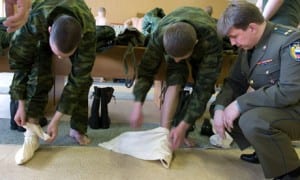They have been standard issue since the days of Peter the Great. But, finally, portyanki have reached the end of the road
They’ve seen service in the Seven Years war, the Napoleonic wars, theCrimean war and two world wars – in fact, in every war the Russian army has fought since the 17th century. But by the end of this year, they’ll be history.
Portyanki, the squares of cloth (cotton for summer, flannel for winter) in which Russian soldiers have wrapped their feet since the days of Peter the Great, have lost their last and greatest battle – against socks.
When US troops met the Red Army at the river Elbe before the final push on Berlin in April 1945, American GIs were astonished to see their formidable Soviet counterparts wearing rags under their boots.
In fact, the cloths – common everywhere before the industrial revolution – were eminently practical: far cheaper to make than socks, quicker and easier to wash, dry and mend, and (providing they were properly bound) fit for purpose. They allowed Russia‘s hard-pressed factories not to be distracted by making socks, and soldiers in the field to improvise replacements if need be.
They did, though, need to be worn correctly. Oleg Dimitriev, a Russia Today journalist who spent two years – or, as he puts it, “695 days” – inportyanki on military service, writes that they could be torture until you got the technique right.
“The most crucial aspect is that one can only wear portyanki that are wrapped tightly,” Dimitriev says. “If the soldier doesn’t follow the procedure exactly, he could hurt his feet and get painful blisters.”
You also had to be able to put your portyanki on fast: Red Army regulations stipulated soldiers had to be fully dressed within 45 seconds. The rags, which inevitably got pretty rancid, were changed weekly, at the same time as the soldier’s shower, and then boiled at 100C.
Partially abandoned in military reforms of 2007, portyanki have now definitively reached the end of the road. Defence minister Sergei Shoigu has ordered that “by the end of 2013 … we need to finally, fully reject this concept in our armed forces”.
Analysts suggest the move is not just about ridding a 21st-century army of footwear more suited to a medieval peasant, but that portyanki have come to symbolise other more significant, but equally outdated, practices favoured by the Russian army that the minister is determined to abolish.



